Anatomy and Function of the Shoulder
or why shoulders often hurt, ache and get stiff
Understanding why your shoulder hurts
Understanding a little bit about the anatomy and function of the shoulder allows you to understand why it gets stiff and painful and even why it leads to neck pain and headaches.
The function of the whole arm and shoulder is to get the hand where it needs to be, to do its job; grip and move things. The shoulder will sacrifice itself to allow the hand to do its job.. this is why we have to know about the anatomy and function of the shoulder area.
The best place to start is with a little bit of the anatomy and functions of the joint and some of the important parts surrounding it. I’m going to keep it easy.
To keep it easy, it’s better to split this into
- The shoulder joint
- The shoulder complex (which isn’t that complex!)
- How it all goes together (or why your neck and shoulder gets stiff and achy)
Table of Contents
The shoulder joint
The shoulder joint, also known as the glenohumeral joint, is described as a ball-and-socket joint where the top part of your arm bone (humerus) fits into a rounded socket in your shoulder blade (scapula). This socket is called the glenoid fossa, or just glenoid for short. The shoulder is the most mobile joint in the body and to make it slightly more stable there’s a little bit called Glenoid Labrum, but that’s not important for now.
To get a picture of how this works, imagine a golf ball on a tee; the ball is much bigger than the tee, just like the ball on the arm bone’s head is bigger than the socket it fits into.
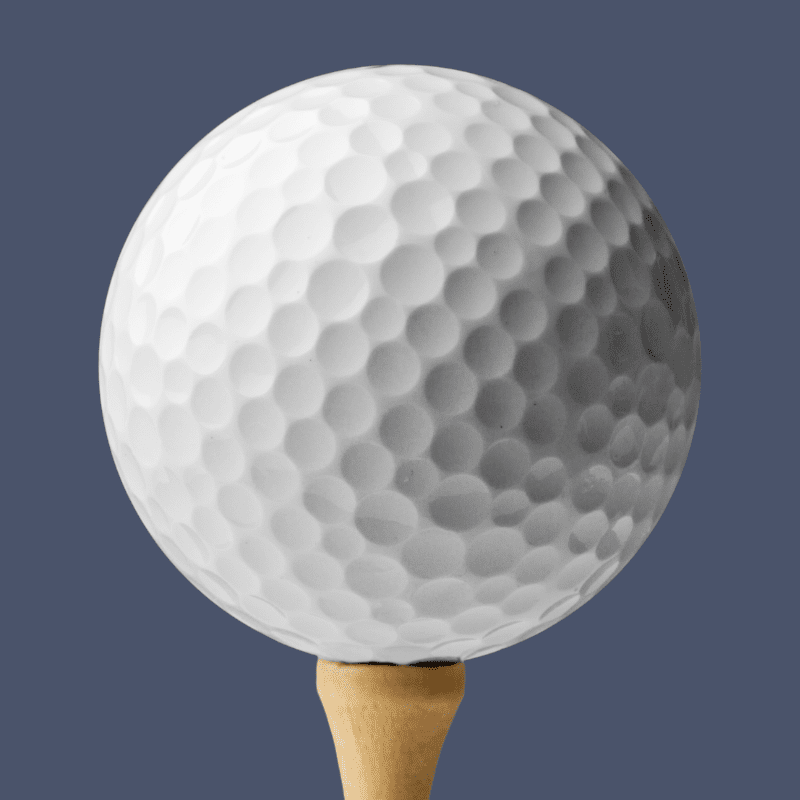
The Anatomy of the Shoulder Joint:
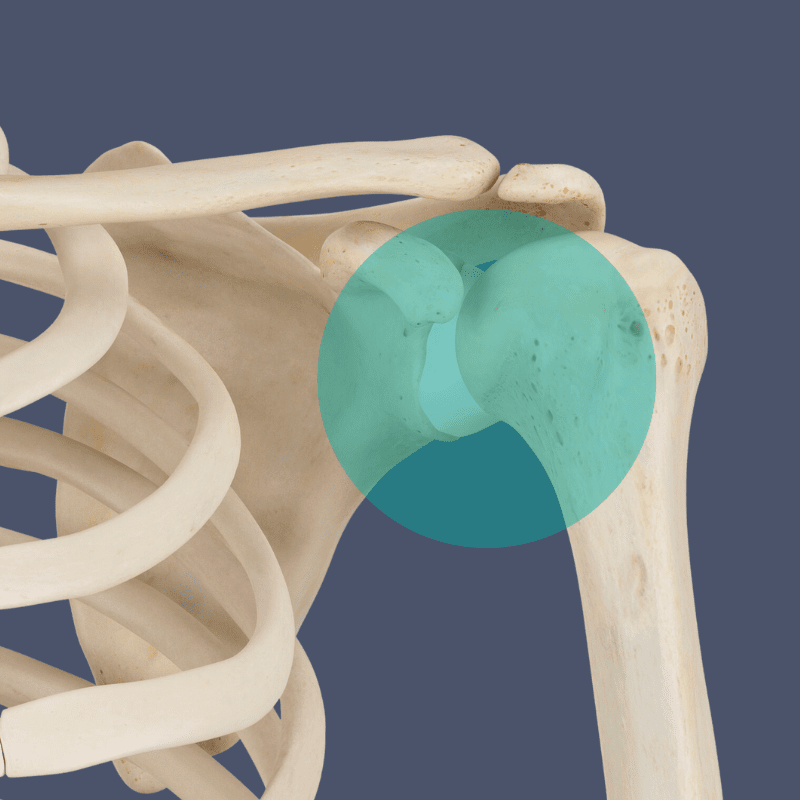
Ball and Socket Design: This design allows your arm to move in almost any direction. This is why you can swing your arm around, lift it up to the side, and rotate it in a circle. It’s the most mobile joint in your body, allowing for a wide range of movements.
Bones and Ligaments: The bones in the joint are held together by tough bands called ligaments. These ligaments provide stability so that the shoulder can move (mostly) without coming out of place.
Muscles of the Shoulder Joint: Large and small muscles surround the shoulder joint. They help move and stabilize the shoulder. The most significant muscle group commonly discussed is the rotator cuff, (there is a separate post on the rotator cuff), just remember there are muscles that help the ligaments keep your shoulder stable and keep it moving
Functional Anatomy of the Shoulder Joint:
Shallow Socket: The shallowness of the glenoid (the socket) means the arm bone has more freedom to move, but it also means that the muscles and ligaments need to work harder to keep it in place. This is why the ligaments and the muscle strength and control around the shoulder are so important.
Wide Range of Motion: The bone structures and the way they are connected allow for a huge variety of movements, from throwing a ball to reaching behind your back. It’s this versatility that lets us use our arms for all sorts of activities that require complex movements.
Flexibility Over Stability: The shoulder joint is designed for flexibility, which is why it has such a wide range of motion, because of this design, it’s not as stable as other ball and socket joints. That’s why the shoulder is the most commonly dislocated joint.
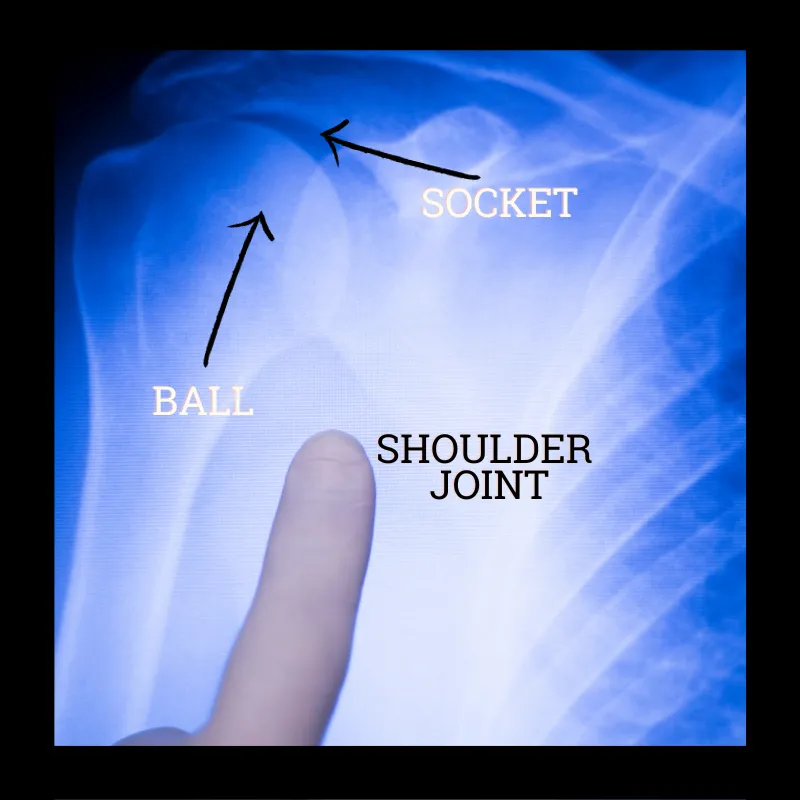
Shoulder joint round-up
The anatomy of the shoulder joint is all about balance: it allows for extensive movement but at the expense of some stability. This is why we can do things like swing a tennis racket or reach up to a high shelf, but at the same time some activities can lead to the shoulder joint dislocating
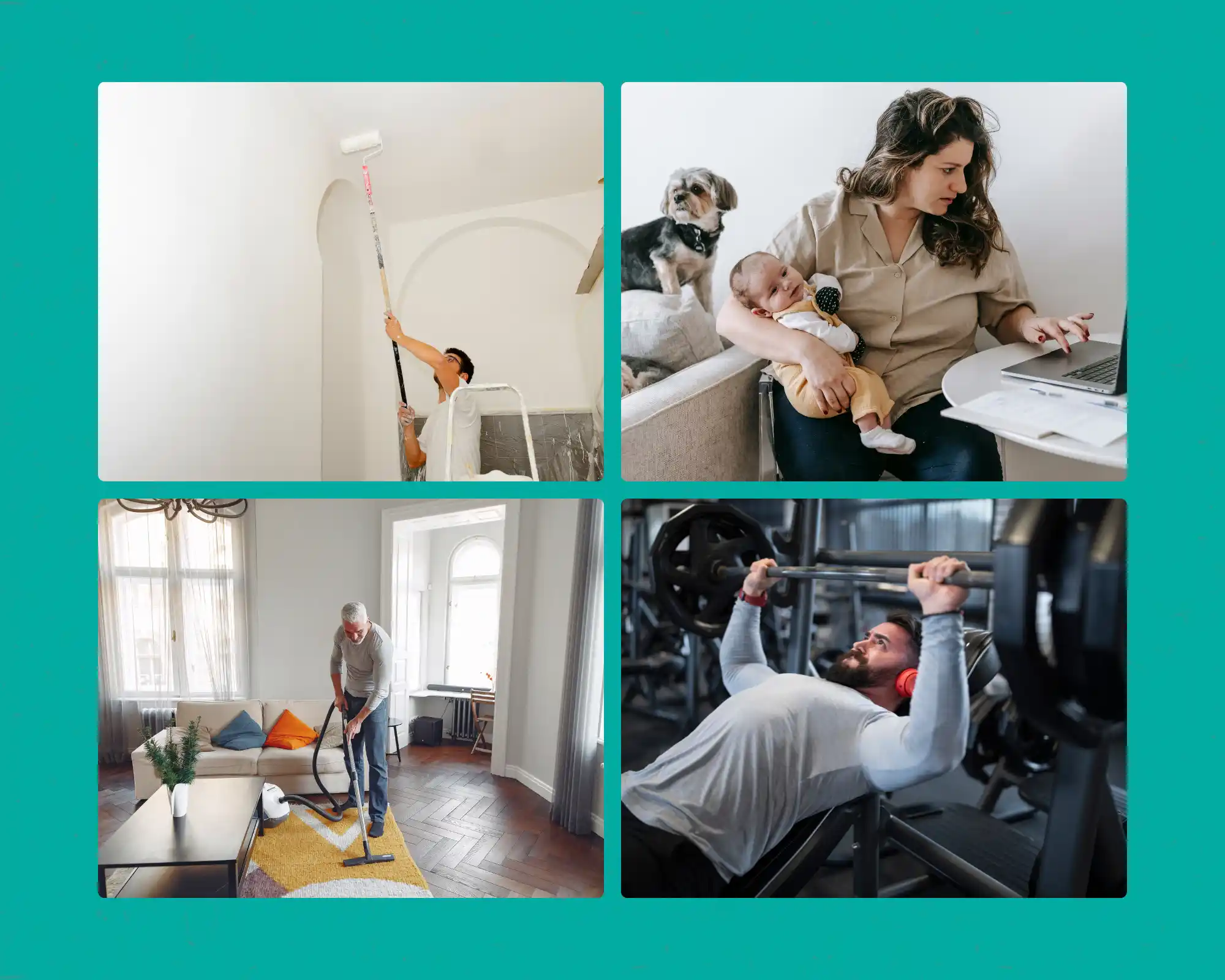
The Shoulder Complex
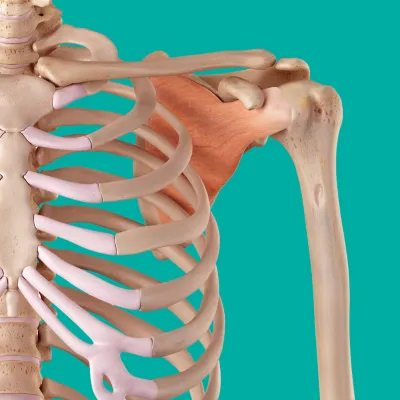
The shoulder complex refers to the whole system of structures in the shoulder region that work together to give the shoulder its wide range of motion.
Unlike the simple ball-and-socket description of the glenohumeral joint, the shoulder complex includes several joints, muscles, tendons, and ligaments that contribute to the shoulder’s function. Here’s a breakdown:
Joints of the Shoulder Complex:
The shoulder complex consists of has 4 bones, 4 joints and a load of muscles
The bones of the shoulder complex
- the humerus (arm bone)
- the clavicle (collarbone)
- the scapular (shoulder blade)
- the sternum (breast bone)
The ribs could also be thought of as bones of the shoulder complex if someone wanted to be picky, but it’s not really…
Shoulder complex images bones and joints
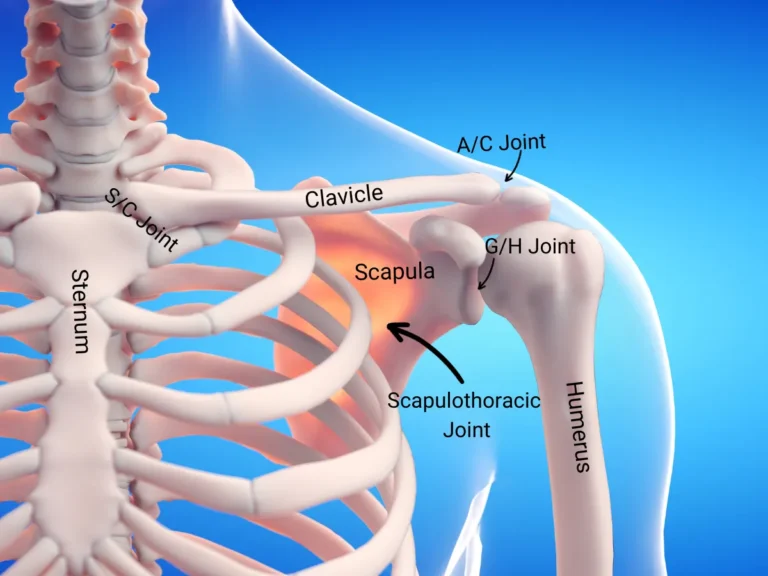
The joints of the shoulder complex
- Glenohumeral Joint: This is the main shoulder joint where the arm bone (humerus) meets the shoulder blade (scapula) in a ball-and-socket arrangement.
- Acromioclavicular (AC) Joint: This joint is where the clavicle (collarbone) meets the acromion, which is a part of the scapula.
- Sternoclavicular (SC) Joint: This is where the clavicle meets the sternum (breastbone) at the base of the neck.
- Scapulothoracic Articulation: This isn’t a true joint with a joint capsule, but rather where the scapula moves over the back side of the ribcage. The movement here is essential for full shoulder motion.
Muscles and Tendons of the Shoulder Complex
Several muscle groups contribute to the shoulder’s movement and stability. Some major ones include:
- The Rotator Cuff: The rotator cuff is a group of four muscles and their tendons that surround the glenohumeral (shoulder) joint. they work to stabilize the shoulder joint by holding the ball firmly within the shallow socket of the scapula (the glenoid fossa)
- Pectoral Muscles: Located on the chest, they help with movements such as bringing the arm in toward the body.
- Deltoid Muscle: This muscle shapes the outer aspect of the shoulder and is crucial for lifting the arm.
- Latissimus Dorsi: Located on the back, it’s involved in bringing the arm down and back.
- Trapezius: This large back muscle helps move the scapula, which is necessary for many arm movements.
- Biceps: Function in the shoulder complex primarily by assisting with the stabilization of the glenohumeral joint during arm movements
Functional Anatomy:
The reason the shoulder can do all these things is due to the intricate interplay between its parts:
- The bones provide structure.
- The joints allow movement in multiple directions.
- The muscles power the movement and stabilize the joints.
- The tendons connect the muscles to the bones, helping transmit the force needed for movement.
- The ligaments help hold the joints together, providing structural stability.
Function of the Shoulder Complex:
- Mobility: The shoulder complex allows for a tremendous range of motion, including forward and backward movements, circular motion, and moving the arms away from and toward the body.
- Stability: While providing mobility, the complex also maintains enough stability to prevent dislocation and provide a firm base for arm movements.
- Force Transmission: It helps transmit forces from the arms to the torso, which is vital for actions like pushing, pulling, and lifting.
The shoulder complex is a sophisticated system that balances flexibility and stability to enable the upper limb to function with a wide range of activities. It’s not just one joint but a coordinated system that allows us to perform intricate tasks with our hands while also having the strength to lift and carry.
How the Shoulder Complex does it all
Right at the beginning of this I said how the function of the whole arm and shoulder is to get the hand where it needs to be to do its job; grip and move things, and that the shoulder will sacrifice itself to allow the hand to do its job, but that’s’s not even half of it..
If we then add in that the muscles to allow the shoulder joint to do its job come from the back, neck and chest as well as local shoulder muscles, we can see how quickly everything gets messed up in and around the shoulder complex..
..and that we can get aches, pains, and stiffness in our back, neck and chest and headaches from this too.
To try and make all these interactions easier to understand, here’s a little analogy..
The shoulder complex is a cleverly designed system of bones, joints, muscles, and ligaments that allows you to move your arm in all sorts of ways while also keeping it stable enough to do tasks that require strength and precision.
Think of the shoulder complex like a mobile crane that can move in almost every direction. This crane isn’t just one piece; it’s made up of several bars and joints that work together to move the ‘arm’ of the crane (your arm) around.
Movement: All these parts work together to let you move your arm up, down, across your body, behind you, and even rotate it in a big circle.
Support: They also help to support and stabilize the arm so you can do things like carry a heavy bag or push open a door.
Functional Anatomy:
Muscles and Tendons: There are a lot of muscles that wrap around the shoulder blade and upper arm. They’re like the wires and pulleys on the crane that pull in different directions to move the arm, but they also hold things tight to keep the joints stable.
Ligaments: These are like strong cables that tie the bones together at the joints. They help make sure the bones don’t move too much and dislocate.
Collarbone: Think of the collarbone like a strut in a building – it’s a rigid support that holds parts of the shoulder complex apart and in place.
It keeps the shoulder blade in the right position so that the arm can hang freely without hitting the side of your ribcage.
Because it’s stiff and attached at both ends to the breastbone (sternum) and shoulder blade, it acts like a beam that helps keep everything in the right place when you move your arm.
It also transfers force from the arm to the skeleton when you push or lift something.
The collarbone is a key part of this, acting like a strut that helps maintain the shoulder’s structure.
The Shoulder Blade:
The Scapula or shoulder blade can also be thought of as a part of a crane
Crane Base and Stability:
In a crane, the base must be stable and robust to support the arm of the crane as it lifts and moves heavy loads.
Similarly, the scapula provides a stable base for the upper arm bone (humerus) and serves as the attachment point for several muscles that move and stabilize the arm.
Movement and Reach:
A crane’s arm pivots at its base to move loads vertically and horizontally. The scapula likewise has an ability to tilt and rotate slightly on the back of the rib cage, thanks to the muscles that attach to it.
This movement is crucial for the arm to reach overhead or behind the back—expanding the range of motion of the shoulder joint.
Load Distribution:
A crane must distribute the weight of its load evenly to prevent toppling over or breaking. The scapula distributes the forces exerted on the shoulder across a larger area, dispersing stress and aiding in the fluid movement of the arm, much like a crane smoothly transitions loads with its arm.
Flexibility for Precision:
The tip of a crane’s arm can be outfitted with different tools or attachments for specific tasks, requiring precise control.
The scapula’s connection to the collarbone (clavicle) at the acromioclavicular (AC) joint and its muscular attachments allow for a wide range of precise movements, enabling the arm to perform complex and delicate tasks.
Dynamic Adjustments:
Just as a crane operator must constantly adjust the crane’s arm to maintain balance and control the load, the muscles around the scapula must continually adjust to control the position of the shoulder blade as the arm moves, ensuring the joint is aligned and the humerus moves smoothly in the socket.
Lifting Mechanism:
Cranes use cables and winches to lift loads. The rotator cuff muscles and the tendons attached to the scapula act like the cables, coordinating to lift the arm, hold it in place, and control its movement with precision.
Through this you can see how the scapula’s role in the shoulder complex mirrors the function of a crane’s base; essential for stability, movement, and control of the arm’s actions.
Using this metaphor helps to emphasize the shoulder blade’s role in providing a stable yet flexible platform for the complex movements of the shoulder and arm and why we need treatment in this area